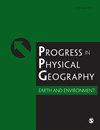俄亥俄河下游的大洪水是从淡水沉积物推断出来的
IF 3.6
3区 地球科学
Q2 GEOGRAPHY, PHYSICAL
Progress in Physical Geography-Earth and Environment
Pub Date : 2023-10-25
DOI:10.1177/03091333231208612
引用次数: 0
摘要
代表过去洪水事件的静水沉积物提供了一种强大的手段,可以进一步扩展系统的测量记录,将历史洪水置于更长期的背景下,并减少洪水危害分析的不确定性。传统上,河流古洪水水文中淡水沉积的识别和应用仅限于干旱基岩控制环境和冰缘环境。在这项研究中,我们利用在潮湿冲积环境中开发的方法,并将其应用于淡水沉积物,这是第一次这样做的研究之一。这种新颖的方法利用沉积物结构和地球化学来区分温带冲积环境中的静水沉积物和原位物质。我们在靠近俄亥俄河下游的悬崖上的两个岩石掩体中发现了多个静水沉积物。洪水年龄估计是基于光激发发光(OSL)测年,流量估计是基于一维HEC-RAS模型。两个地点的最上层的平流沉积物对应于公元1937年的历史洪水记录(~ 31,400 m³/s),而仅在较低海拔地点发现的另一个平流沉积物对应于公元1650年左右发生的古洪水,流量为~ 23,900 m³/s。我们的研究结果表明,公元1937年的洪水代表了至少过去400年来俄亥俄河下游最大的洪水。将古洪水纳入路易斯维尔俄亥俄河的洪水频率分析,将大洪水分位数的不确定性降低了约50%。本文章由计算机程序翻译,如有差异,请以英文原文为准。
Large floods on the lower Ohio River inferred from slackwater deposits
Slackwater deposits representing past flood events provide a robust means to extend systematic gage records further back in time, place historic floods in a longer-term context, and reduce uncertainties in flood hazard analysis. The identification and application of slackwater deposits in riverine paleoflood hydrology has traditionally been limited to arid bedrock-controlled environments and periglacial environments. In this study, we utilize methods developed in humid alluvial settings and apply them to slackwater deposits, one of the first studies to do so. This novel approach uses sediment texture and geochemistry to distinguish slackwater deposits from in situ material in a temperate alluvial setting. We identify multiple slackwater deposits in two rock shelters situated on bluffs adjacent to the lower Ohio River. Flood age estimates are based on optically stimulated luminescence (OSL) dating, and discharge estimates are based on a 1D HEC-RAS model. The uppermost slackwater deposit at both sites corresponds to the AD 1937 historic flood of record (∼31,400 m 3 /s), while another slackwater deposit identified only at the lower elevation site corresponds to a paleoflood that occurred around AD 1650 with a discharge of ∼23,900 m 3 /s. Our findings imply that the AD 1937 flood represents the largest magnitude flood on the lower Ohio River in at least the last 400 years. Inclusion of the paleoflood into a flood frequency analysis for the Ohio River at Louisville reduces uncertainties in large flood quantiles by ∼50%.
求助全文
通过发布文献求助,成功后即可免费获取论文全文。
去求助
来源期刊
CiteScore
7.20
自引率
5.10%
发文量
53
审稿时长
>12 weeks
期刊介绍:
Progress in Physical Geography is a peer-reviewed, international journal, encompassing an interdisciplinary approach incorporating the latest developments and debates within Physical Geography and interrelated fields across the Earth, Biological and Ecological System Sciences.

 求助内容:
求助内容: 应助结果提醒方式:
应助结果提醒方式:


